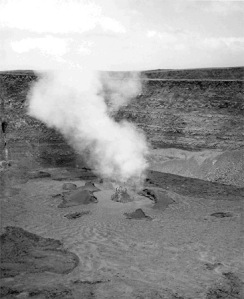Reprinted from here.
 | |
| Light detection and ranging (LiDAR) image of the southeast wall and currently active pit crater of Halema`uma`u. Image courtesy of Todd Erickson, Pacific GPS Facility SOEST University of Hawaii, Manoa. | |
This month, researchers from the University of Hawai`i teamed up with the Hawaiian Volcano Observatory staff to use laser-based technology to peer into the depths of a new pit in Halema`uma`u. What they saw was startling. The look revealed that the vent has a cavernous interior that dwarfs the size of the opening that we see at the surface. The cavern is approximately 200 m (650 ft) below the floor of Halema`uma`u, making it a dizzying 285 m (935 ft) below the now-closed Halema`uma`u overlook area.
To obtain the image, the UH researchers were using a technology called Light Detection and Ranging, or LiDAR, for short. By bouncing pulses of lasers off objects, LiDAR can determine the distance to out-of-reach objects. Readers may be familiar with similar technology used in the laser range finders employed by golfers, hunters, and builders. Simple laser range finders measure a single distance to an object. In contrast, scientist using LiDAR data can produce entire images, or models, of distant surfaces based on thousands of individual laser bounces.
The remarkable part of the image is that it reveals a very deep pit crater with dramatic overhanging walls near the surface. This is different from the steep and vertical walls of the larger Halema`uma`u and Kilauea caldera.
What the image actually reveals is a snapshot in the evolution of a Hawaiian pit crater. "Pit crater" is a general term used to describe the steep-sided, semi-circular, and flat-bottomed craters that are characteristic of the summit and rift zone areas of Kilauea and Mauna Loa volcanoes. Interchangeable terms for these features include, "collapse crater", and of course the eloquent Hawaiian name for a pit, "lua". But how are these craters created?
Looking into this deep hole created by a volcano may lead one to think that all the material was blasted out. But if this were the case, we would be able to see a vast amount of excavated material deposited around the rim of the pit. In fact, the amount of ejected material, or ejecta, surrounding Hawaiian pit craters is relatively small -- far less than the amount of material required to fill the hole back up. And, some Hawaiian pit craters do not have any ejecta surrounding them.
The answer to how pit craters form is being witnessed right now as the new vent evolves. Hawaiian pit craters form primarily through the evacuation, or loss, of magma somewhere beneath the vent. As magma evacuates from the plumbing system below, the conduits collapse and the vent floor sinks away. The walls may become overhung, since the interior of the pit expands as it drops. Eventually, the overhung portions of the rim collapse into the pit, and the characteristic near-vertical sides of the pit crater are formed.
Our observations of lava within the vent, data from instrumentation, and measurements of magma flux at the east rift zone near Kalapana, suggest that the amount of magma within the plumbing system of Kilauea has been reduced. This ebbing has caused the drop in the lava level and the growth of the cavern we now see. The recent pulses of ash-laden plumes issuing from Halema`uma`u have been caused by collapses of the pit's overhanging rim.
Of course, the drop in the vent floor, and ebb in the flow of magma within the system, does not necessarily mean the eruption is winding down. A characteristic behavior of Hawaiian pit craters is that the floor may refill with a lava lake, only to drain and collapse again and again. So the laser's look into the lua is certainly only a snapshot of the on-going evolution of Halema`uma`u.
Kīlauea Activity Update
Surface flows have been active on the pali within Royal Gardens subdivision throughout the past week, burning forest and one unoccupied structure. At the coast, the Waikupanaha and Kupapa`u ocean entries remain active and continue to produce steam plumes and small littoral explosions.
The vent at Kīlauea's summit was dark and quiet all week, producing only a very small quantity of rock dust from small collapses of the vent walls. The plume has been thin and wispy, and volcanic gas emissions have been relatively low. They are, however, still elevated above background levels, resulting in high concentrations of sulfur dioxide downwind.
One earthquake beneath Hawai`i Island was reported felt this past week. A magnitude-2.8 earthquake occurred at 10:38 p.m., H.s.t. on Thursday, July 9, 2009, and was located 3 km (2 miles) south of Holualoa at a depth of 36 km (22 miles).
Visit our Web site (http://hvo.wr.usgs.gov) for detailed Kīlauea and Mauna Loa activity updates, recent volcano photos, recent earthquakes, and more; call (808) 967-8862 for a Kīlauea activity summary; email questions to askHVO@usgs.gov.
For more information on visiting Hawaii in general and touring Hawaii Volcanoes National Park in particular, please also visit www.lovingthebigisland.wordpress.com and www.tourguidehawaii.com.





